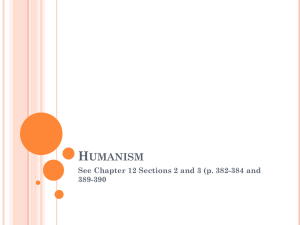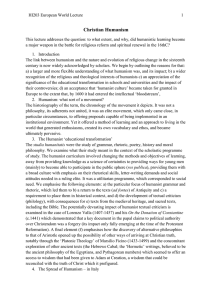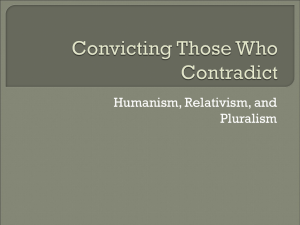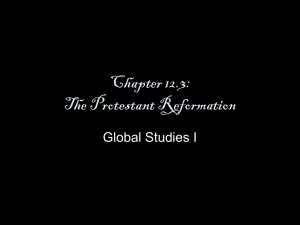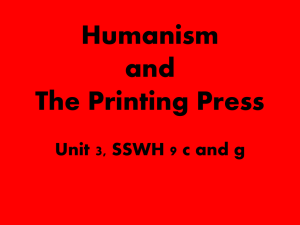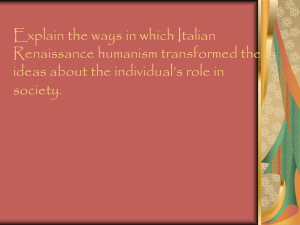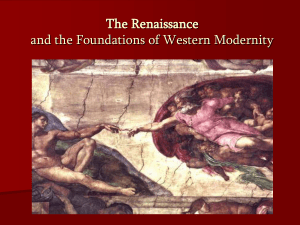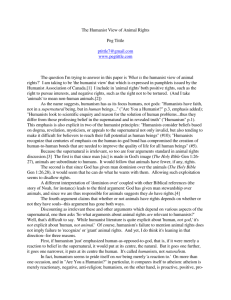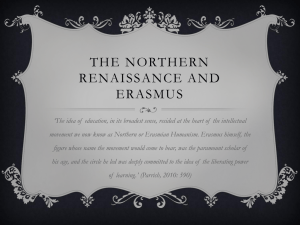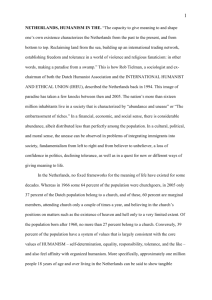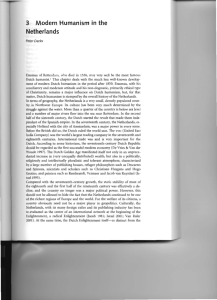How did the Italian Renaissance influence northern Europe?
advertisement
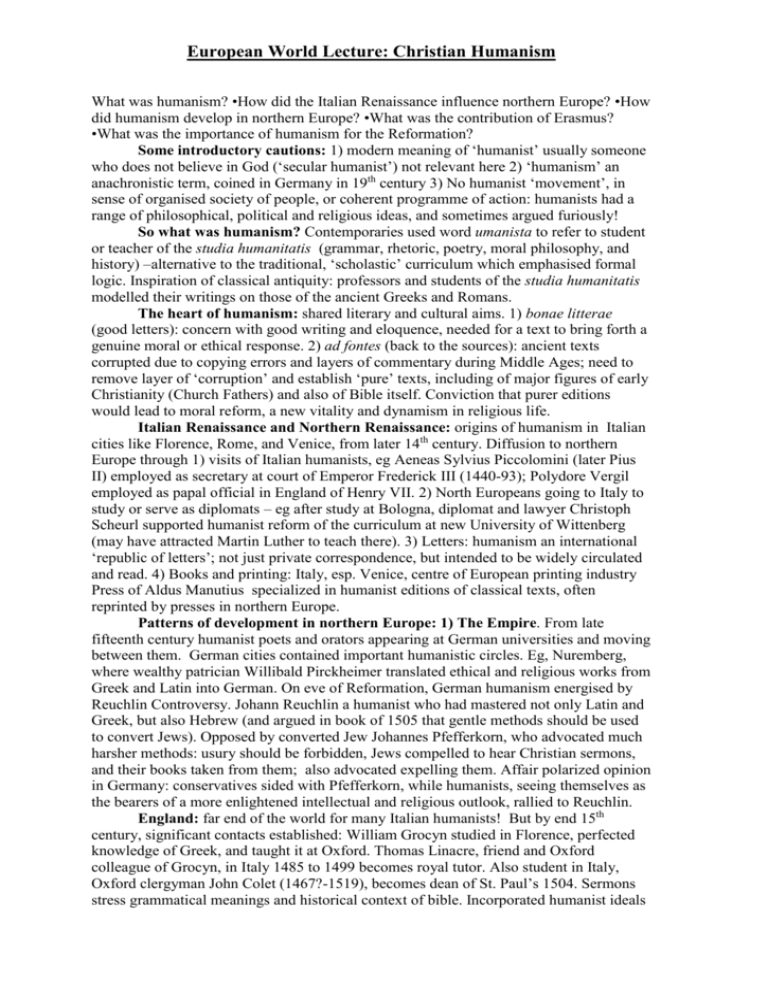
European World Lecture: Christian Humanism What was humanism? •How did the Italian Renaissance influence northern Europe? •How did humanism develop in northern Europe? •What was the contribution of Erasmus? •What was the importance of humanism for the Reformation? Some introductory cautions: 1) modern meaning of ‘humanist’ usually someone who does not believe in God (‘secular humanist’) not relevant here 2) ‘humanism’ an anachronistic term, coined in Germany in 19th century 3) No humanist ‘movement’, in sense of organised society of people, or coherent programme of action: humanists had a range of philosophical, political and religious ideas, and sometimes argued furiously! So what was humanism? Contemporaries used word umanista to refer to student or teacher of the studia humanitatis (grammar, rhetoric, poetry, moral philosophy, and history) –alternative to the traditional, ‘scholastic’ curriculum which emphasised formal logic. Inspiration of classical antiquity: professors and students of the studia humanitatis modelled their writings on those of the ancient Greeks and Romans. The heart of humanism: shared literary and cultural aims. 1) bonae litterae (good letters): concern with good writing and eloquence, needed for a text to bring forth a genuine moral or ethical response. 2) ad fontes (back to the sources): ancient texts corrupted due to copying errors and layers of commentary during Middle Ages; need to remove layer of ‘corruption’ and establish ‘pure’ texts, including of major figures of early Christianity (Church Fathers) and also of Bible itself. Conviction that purer editions would lead to moral reform, a new vitality and dynamism in religious life. Italian Renaissance and Northern Renaissance: origins of humanism in Italian cities like Florence, Rome, and Venice, from later 14th century. Diffusion to northern Europe through 1) visits of Italian humanists, eg Aeneas Sylvius Piccolomini (later Pius II) employed as secretary at court of Emperor Frederick III (1440-93); Polydore Vergil employed as papal official in England of Henry VII. 2) North Europeans going to Italy to study or serve as diplomats – eg after study at Bologna, diplomat and lawyer Christoph Scheurl supported humanist reform of the curriculum at new University of Wittenberg (may have attracted Martin Luther to teach there). 3) Letters: humanism an international ‘republic of letters’; not just private correspondence, but intended to be widely circulated and read. 4) Books and printing: Italy, esp. Venice, centre of European printing industry Press of Aldus Manutius specialized in humanist editions of classical texts, often reprinted by presses in northern Europe. Patterns of development in northern Europe: 1) The Empire. From late fifteenth century humanist poets and orators appearing at German universities and moving between them. German cities contained important humanistic circles. Eg, Nuremberg, where wealthy patrician Willibald Pirckheimer translated ethical and religious works from Greek and Latin into German. On eve of Reformation, German humanism energised by Reuchlin Controversy. Johann Reuchlin a humanist who had mastered not only Latin and Greek, but also Hebrew (and argued in book of 1505 that gentle methods should be used to convert Jews). Opposed by converted Jew Johannes Pfefferkorn, who advocated much harsher methods: usury should be forbidden, Jews compelled to hear Christian sermons, and their books taken from them; also advocated expelling them. Affair polarized opinion in Germany: conservatives sided with Pfefferkorn, while humanists, seeing themselves as the bearers of a more enlightened intellectual and religious outlook, rallied to Reuchlin. England: far end of the world for many Italian humanists! But by end 15th century, significant contacts established: William Grocyn studied in Florence, perfected knowledge of Greek, and taught it at Oxford. Thomas Linacre, friend and Oxford colleague of Grocyn, in Italy 1485 to 1499 becomes royal tutor. Also student in Italy, Oxford clergyman John Colet (1467?-1519), becomes dean of St. Paul’s 1504. Sermons stress grammatical meanings and historical context of bible. Incorporated humanist ideals 2 of ‘good letters’ into statutes for St Paul’s School (founded 1510). Most influential English humanist = lawyer Thomas More (1478-1535), friend of Grocyn, Linacre, Colet, and Erasmus. In 1516 published Utopia, the greatest achievement of English humanism – advocates reform through playful satire and complex layers of fiction. France: medieval France maintained tradition of classic learning, and during Avignon papacy works of Dante, Petrarch, and Boccaccio well known. University of Paris leading centre of ‘scholastic learning’, but humanism established there from late 15th century, and university split by Reuchlin Affair. New king Francis I (1515) genuinely interested in humanism, and sister Marguerite of Angoulême, significant patron of church reform. French humanism had serious religious tone: moving force, Jacques Lefèvre d’Étaples (c. 1455-1536). Like Colet, sharp critic of clerical abuses and advocates literal interpretation of scripture. Colet, More, Lefèvre, and others friends and disciples of... Humanist Superstar: Erasmus of Rotterdam: by far most influential Christian humanist, and creator of ambiguous legacy. Advocate of the ‘Philosophia Christi’ (philosophy of Christ): a simple, ethical Christianity, unencumbered by unnecessary rituals and ‘superstition’ – ideals put forward in his Enchiridion militis Christiani (Handbook of the Christian Soldier) of 1503. Relentless mocker of scholastic ‘subtlety’, eg in his Moriae Encomium (Praise of Folly), 1511. But NB, Erasmus not an outsider or a rebel – receives patronage from popes, and aristocracy and royalty across Europe. Heart of Erasmus’s vision for reform is renewed engagement with original Christian sourcetext, New Testament (ad fontes!). Italian humanist Lorenzo Valla (1407-57) compared Greek manuscripts against Vulgate and found hundreds of minor slips and errors. 1505 Erasmus publishes Valla’s notes, and in 1516 his own Latin and Greek version, the Novum Instrumentum. Enthusiastically welcomed by humanist supporters, but some conservatives thought to criticise Vulgate was to attack authority of the Church. Radical notes and translation choices – eg for Greek metanoiete proposed resipiscite (repent) rather than Vulgate’s paenitentiam agite (do penance) – undermining sacrament of confession? Humanism and the Reformation: Erasmus complains people are saying ‘I laid the egg and Luther hatched it’. Humanism conventionally seen as one of the ‘causes’ or ‘preconditions’ of the Reformation: encourages climate of criticism of received wisdom and traditional authority; Christian humanism often hostile to popular religion of shrines, relics, miracles, saints’ cults; shared emphasis on authority of the bible, and impatience with scholastic ‘obscurantism’. When Luther protested against indulgences in 1517, many humanists rushed to support him (saw this as continuation of the Reuchlin controversy). Some early Protestant reformers were strongly humanist, especially Ulrich Zwingli in Switzerland. In his fight against traditional theology, Luther used the Bible and the Church Fathers in their new humanist editions. But... relationship not straightforward. Erasmus has initial sympathy with Luther, but never breaks with the Roman Church. Publicly falls out with Luther in 1525 over question of the freedom of the will (Luther’s stress on total depravity of mankind distinctly unhumanist!) Some leading humanists (eg Thomas More and John Fisher in England) ferocious opponents of Protestantism. Reformation splits Christian humanism: strong humanist currents in both the Reformation and Catholic Counter-Reformation. Most early sixteenth century Christian humanists wanted to revitalise the existing religious and devotional life of the Church with a new ethos or spirit. Protestant reformers saw basic problem not as a lack of ‘eloquence’ and good letters, or even an excess of ‘superstition’, or a lack of familiarity with the Bible – but that the basic theological teaching of the Church was fundamentally wrong! Their ad fontes meant tearing up centuries of Christian teaching, and starting again from the beginning...
